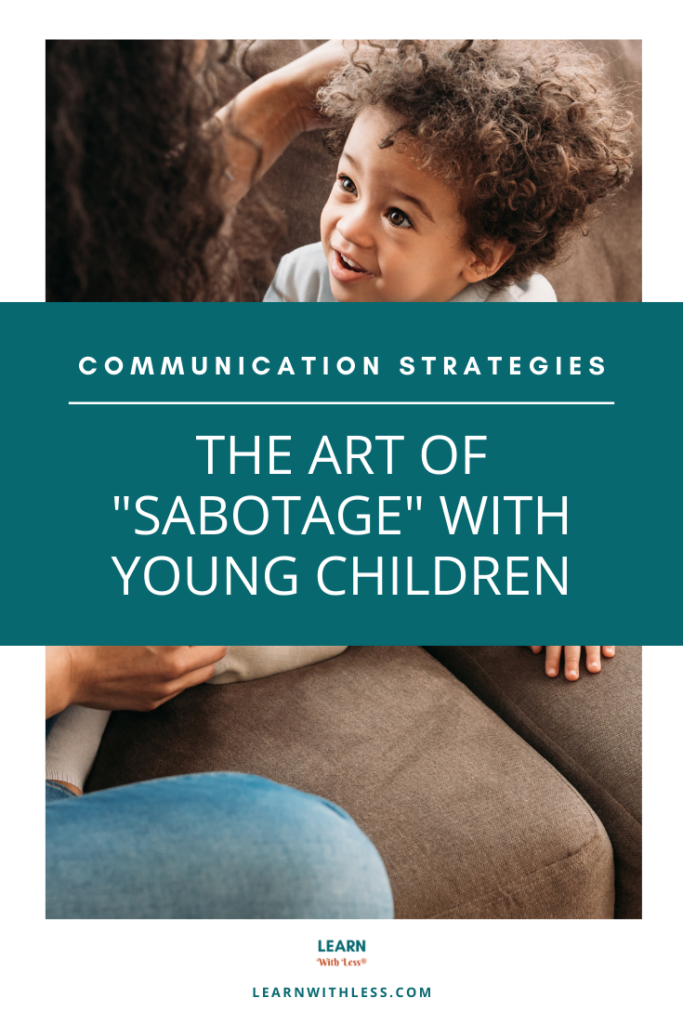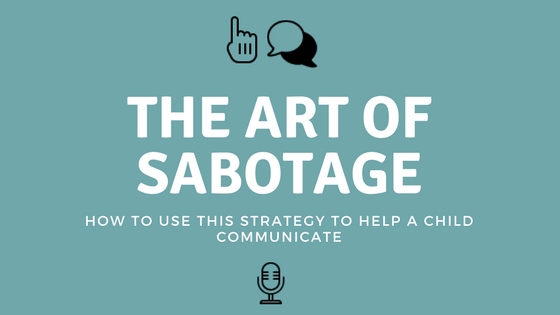Looking for tricks to “make” your little one communicate?

There are little tools we have. We, who work with little people, have tricks of the trade. One of them is the ability to tempt your small child into communicating.
On this episode of Learn With Less, Ayelet tells you all about this early communication strategy, known as “sabotage,” but also discusses why it’s a tool to tempt your child – not to “make” your child do anything.
Within this podcast episode, we model ways to play, talk, sing, and move in order to support learning and development, using the things you already have laying around your home.
To learn more about these four pillars of the Learn With Less® curriculum, you can download my free infant/toddler development blueprint.
Below is the transcript of this week’s “Developmental Thought,” an excerpt from the full episode.
For additional information, music, play ideas and the complete interactive family experience, please listen to the entire episode.
Related Links to This Episode to Support Early Development
How to create your own box of communicative temptations using the things you already have in your home – our corresponding blog post.
Download our free Infant/Toddler Development Blueprint, outlining major areas of learning and development in the first three years of life, and how you can support them using our four pillars of play, talk, sing, & move
Learn With Less® Bundle: get our favorite infant and toddler development resources (save 70%)! Discover how to support & connect with your tiny human, without having to buy a single toy. Includes our bestselling books, our family music album, a full Learn With Less® “caregiver & me” class, and a caregiver handout outlining everything we covered so you can do it again and again at home!
Learn With Less® Expand Your Impact Workshop Bundle: If you’re an educator or therapist type who’s interested in providing family enrichment services to families in your community, but you’re not sure where to start, grab our bundle of 4 value-packed workshops & discover how you can serve your community & support yourself, using your existing skills.
Learn With Less® Facilitator Training & Certification Program: Use your existing skills as an educator or therapist to serve families holistically with a high quality program that will provide lasting impact! Apply now to become a licensed facilitator Learn With Less®.
Learn With Less® “Caregiver & Me” Classes: the magic of Learn With Less® lies in the communal aspect of coming together with our resources, in community with other families. Join us for a virtual or in-person class led by a licensed facilitator near you!
Connect With Us: Instagram / Facebook
Text Transcript of this Episode
Today I want to talk about one of the strategies I use to promote early communication, both as a mother and as a therapist. This particular strategy has a bit of a funny name: we call it “sabotage.”
Essentially, the idea is that the adult creates a situation wherein the child has to communicate to solve a problem. You are obstructing their path in some way.
Kindness is Key
Now, since you are purposefully creating a situation wherein your little one has to solve a problem, it’s very important that you do this kindly! It’s ok if your child becomes mildly frustrated, but we don’t want to make our little ones feel like they are failing.
This relates to our discussion in my episode, “Not Too Much Or Too Little: Channeling Goldilocks,” and the fact that infants and toddlers are constantly making assessments about whether something is so difficult that it’s not even worth attempting. We want to make expectations that are within their reach, but at a slightly higher level than where they’re comfortable.
The technical term for this is called “scaffolding,” and I think it’s a wonderful visual image – think of creating a little boost for them to get to the next step up. We don’t want the next step up to seem too far away, but we want to expect slightly more than what they’re currently doing.
Silly Set-Up
There are many ways to set up the opportunity to sabotage your older infant or toddler to encourage them to initiate communication. A nice way to think of your role as the “setter-upper” of a sabotage situation is that you are being silly – a routine with a step missing, or a toy with an essential part missing becomes over the top and ridiculous if your little one points out that something’s “wrong,” and you can react with humor.
Set Up Temptations
Movement and gesture, song and rhyme are all wonderful tools to use with infants and toddlers to help set up an environment conducive to learning, play and interaction. We spoke earlier about setting up “temptations” for communication and using the strategy of sabotage. Now, I think this strategy is a wonderful one when used kindly and as a tool for learning.
But that word, sabotage really brings up some negative connotations, as well, as it is defined as the deliberate obstruction or disruption of another. I think perhaps, a better way to think of this strategy is, in a way, a technique for scaffolding: we want our little ones to get to the “next level,” so we place small challenges in front of them to assist in their learning, and to create new opportunities for them. In other words – we have to make it a fun and positive challenge.
We spoke about this a bit earlier in our episode, and I modeled a way to make yourself seem silly and ridiculous. In episodes past, we’ve talked about the importance of getting down and dirty with your “silly self,” because it can be a great way to connect and make yourself more interesting. This is no different.
If you put your foot down and create a situation wherein your child MUST perform OR ELSE, then the strategy will most likely fail. This is a communication temptation – you are tempting your child to do something. Not forcing them. So, just to be clear, I’m not supporting an “all or nothing” approach. I’m suggesting you try something new out, and see how it goes.
Small Steps
We also want to encourage small steps toward new skills. If your child has never used the pointing gesture, this is what you can work toward… by modeling that gesture a lot in lots of activities you do or interactions you have, and then as a suggestion that this is what you expect from her.
If your child has never said the word, “open,” but is starting to use words or imitate the first sound of a word, work towards that! In other words, we’re not using the art of sabotage to make unrealistic expectations on our little ones. We actually want to use the strategy of sabotage to get our little ones to initiate or do things that they’ve already done before – you are putting this strategy in place to help push them towards a skill that you know they can be successful doing!
And if your strategy and your modeling and your set-up of this activity doesn’t work, that’s ok! Try again another time, or in another way! For a clear example of the set-up of an activity that utilizes the strategy of sabotage, and ideas for how to modify your expectations for different developmental levels, visit the corresponding activity, my DIY Box of Communication Temptations.
The Right Level
On that note, we don’t want to be using this strategy all the time, in every activity we do, all day long. This goes back to being kind, and to trying different things at different times. We don’t want to ask our kids to “perform” all day – that’s not terribly interactive, either.
And for some little ones, no matter how kind or silly you might try to be, the fact that you’re creating a new challenge where there was not one before might make her really, really mad and turn her off completely. We don’t want that. We want moderate difficulty, tools in place to make it easier, and a present and kind caregiver.
One last note on this – sabotage is most effective when a little one is able to engage in joint attentional acts. We’ve spoken about joint attention in previous episodes, in my bestselling books, and in our “caregiver & me” classes using the Learn With Less® curriculum – it’s that focus between you and your child not only on an object, but also a recognition that you’re both engaged with that object or activity. So, making eye contact, getting your attention with a touch or gesture, vocalizing or verbalizing, etc.
Bring families together (virtually or in-person) so they can learn with you and from one another!
For more great ideas and information on sabotage & setting up communication temptations:
Bowen, C. (2011). Supporting speech and language progress in children with CAS or sCAS. Retrieved from http://www.speech-language-therapy.com/ on June 24, 2016.
Mize, L. (2008). A Little Frustration CAN Go A Long Way… Using Sabotage and Witholding Effectively to Entice Your Toddler To Talk. Retrieved from http://www.teachmetotalk.com/ on June 22, 2016.
